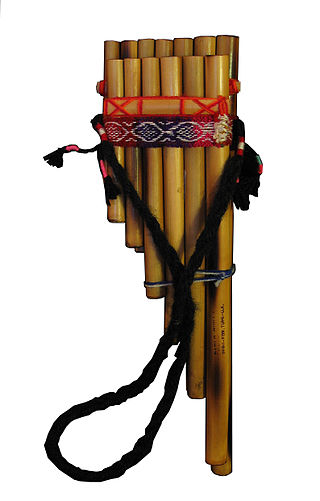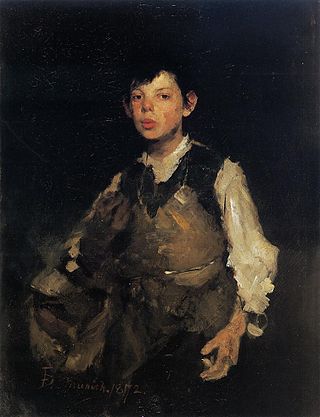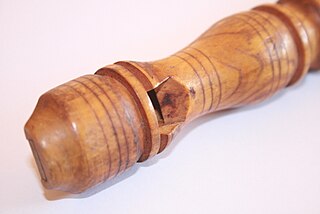
The flute is a member of a family of musical instruments in the woodwind group. Like all woodwinds, flutes are aerophones, producing sound with a vibrating column of air. Unlike woodwind instruments with reeds, a flute produces sound when the player's air flows across an opening. In the Hornbostel–Sachs classification system, flutes are edge-blown aerophones. A musician who plays the flute is called a flautist or flutist.

A pan flute is a musical instrument based on the principle of the closed tube, consisting of multiple pipes of gradually increasing length. Multiple varieties of pan flutes have been popular as folk instruments. The pipes are typically made from bamboo, giant cane, or local reeds. Other materials include wood, plastic, metal and ivory.

The tin whistle, also called the penny whistle, is a simple six-holed woodwind instrument. It is a type of fipple flute, putting it in the same class as the recorder, Native American flute, and other woodwind instruments that meet such criteria. A tin whistle player is called a whistler. The tin whistle is closely associated with Irish traditional music and Celtic music. Other names for the instrument are the flageolet, English flageolet, Scottish penny whistle, tin flageolet, or Irish whistle.

An aerophone is a musical instrument that produces sound primarily by causing a body of air to vibrate, without the use of strings or membranes, and without the vibration of the instrument itself adding considerably to the sound.

The ocarina is a wind musical instrument; it is a type of vessel flute. Variations exist, but a typical ocarina is an enclosed space with four to twelve finger holes and a mouthpiece that projects from the body. It is traditionally made from clay or ceramic, but other materials are also used, such as plastic, wood, glass, metal, or bone.

Whistling without the use of an artificial whistle is achieved by creating a small opening with one's lips, usually after applying moisture and then blowing or sucking air through the space. The air is moderated by the lips, curled tongue, teeth or fingers to create turbulence, and the curled tongue acts as a resonant chamber to enhance the resulting sound by acting as a type of Helmholtz resonator. By moving the various parts of the lips, fingers, tongue and epiglottis, one can then manipulate the types of whistles produced.
Overblowing is the manipulation of supplied air through a wind instrument that causes the sounded pitch to jump to a higher one without a fingering change or the operation of a slide. Overblowing may involve a change in the air pressure, in the point at which the air is directed, or in the resonance characteristics of the chamber formed by the mouth and throat of the player.

The term fipple specifies a variety of end-blown flute that includes the flageolet, recorder, and tin whistle. The Hornbostel–Sachs system for classifying musical instruments places this group under the heading "Flutes with duct or duct flutes." The label "fipple flute" is frequently applied to members of the subgroup but there is no general agreement about the structural detail of the sound-producing mechanism that constitutes the fipple, itself.
The Western concert flute is a family of transverse (side-blown) woodwind instruments made of metal or wood. It is the most common variant of the flute. A musician who plays the flute is called a “flautist” in British English, a “flutist” in American English.

Helmholtz resonance or wind throb is the phenomenon of air resonance in a cavity, such as when one blows across the top of an empty bottle. The name comes from a device created in the 1850s by Hermann von Helmholtz, the Helmholtz resonator, which he used to identify the various frequencies or musical pitches present in music and other complex sounds.
The Native American flute is a musical instrument and flute that is held in front of the player, has open finger holes, and has two chambers: one for collecting the breath of the player and a second chamber which creates sound. The player breathes into one end of the flute without the need for an embouchure. A block on the outside of the instrument directs the player's breath from the first chamber—called the slow air chamber—into the second chamber—called the sound chamber. The design of a sound hole at the proximal end of the sound chamber causes air from the player's breath to vibrate. This vibration causes a steady resonance of air pressure in the sound chamber that creates sound.

The music of the ancient Mayan courts is described throughout native and Spanish 16th-century texts and is depicted in the art of the Classic Period. The Maya played instruments such as trumpets, flutes, whistles, and drums, and used music to accompany funerals, celebrations, and other rituals. Although no written music has survived, archaeologists have excavated musical instruments and painted and carved depictions of the ancient Maya that show how music was a complex element of societal and religious structure. Most of the music itself disappeared after the dissolution of the Maya courts following the Spanish Conquest. Some Mayan music has prevailed, however, and has been fused with Spanish influences.

A nose whistle is a wind instrument played with the nose and mouth cavity. Often made of wood, they are also constructed with plastic, clay, or sheet metal.

Apito, which is the Portuguese word for "whistle", refers to any of a variety of whistles.

A wind instrument is a musical instrument that contains some type of resonator in which a column of air is set into vibration by the player blowing into a mouthpiece set at or near the end of the resonator. The pitch of the vibration is determined by the length of the tube and by manual modifications of the effective length of the vibrating column of air. In the case of some wind instruments, sound is produced by blowing through a reed; others require buzzing into a metal mouthpiece, while yet others require the player to blow into a hole at an edge, which splits the air column and creates the sound.

A shepherd's whistle is a specialized, modulatable, variable-pitch whistle used to train and transmit commands to working dogs and other animals. Unlike other whistles, they are placed inside the mouth. The pitch is controlled by the placement of the tongue; physically, shepherd's whistles are vessel flutes with the tongue forming one side of the resonating chamber, and controlling its size. Like tin whistles, while simple, they can be used as musical instruments in their own right.

Taonga pūoro are the traditional musical instruments of the Māori people of New Zealand.

A vessel flute is a type of flute with a body which acts as a Helmholtz resonator. The body is a vessel-shaped, not a tube- or cone-shaped; that is, the far end is closed.
The musical leaf is one of any leaves which is used to play music on. It goes by many names, including leaflute, leaf flute, leaf whistle, gum leaf, and leafophone. In Cambodia it is called a slek and is played by country people in Cambodia, made from the leaves of broad-leaf trees, including the sakrom and khnoung trees. It is also known as phlom slek, 'blow leaf.' To play a leaf, the musician curls the edge of a leaf into a semi-circle and "places the arch between the lips", making sure that the leaf is touching both upper and lower lips. The leaf vibrates in contact with them as the player blows air across it. The player can control the pitch of the noise with their upper lip.















